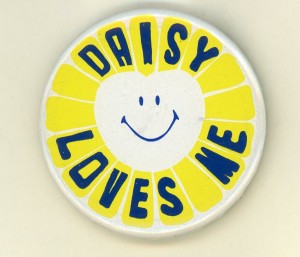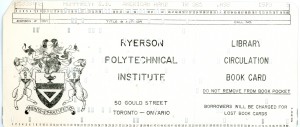??Computing will most undoubtedly prove to be the most significant development to technology in the second half of the twentieth century. The extent to which Ryerson students graduate with a firm understanding of this new and exciting field, will greatly affect their ability to contribute to society.??
- L.B. Moore, Director of the Ryerson Computing Centre, 1973.

A classroom scene in the Secretarial Science program, 1962. (RG 95.1.1679.10)
Ryerson University began as a polytechnic institute devoted to the training of students in applied technology. This technical history has informed Ryerson?s identity and culture, playing a significant role in the way the University defines its relationship to the digital age. As we enter an era of ever changing technology and a digitally-connected society, a look back at the early days of computing at Ryerson highlights the development of a digital campus and its impact on the Ryerson way of life.
DAISY

Ryerson?s first computer centre with DAISY and connected terminals. (RG 63.72)
Always at the forefront of innovation, Ryerson?s early use of computing technology began in the 1960s when Ryerson was one of the first institutions to acquire a general purpose computer, an IBM Model 360-30, affectionately nicknamed ?DAISY? (Direct Access Information System).

?Daisy? Chooses Miss Ryerson ?68?. One of the many ?jobs? DAISY performed. (The Rambler, Summer 1968)
It?s difficult to imagine a world without smart phones or even personal computers, but the early days of computing at Ryerson involved the use of one centralized system that students would line up to use. Eventually this changed to include the addition of terminals throughout campus that would connect via Bell phone lines to the main computer. The main functions were academic and administration assistance, including student registration, payroll, scheduling, grades, library circulation, and the occasional selection of Miss Ryerson.

?DAISY LOVES ME? Button. Students had a hate/love relationship with the overworked computer. (RG 63.71)
DAISY was not without its quirks. Nearing the end of its?life-cycle the first model would confuse library punch cards and harass students with overdue notices on books that had been returned. In 1975 DAISY took the initiative of creating a brand new Journalism class consisting of three surprised students.
DAISY would be upgraded three times, 1967, 1969, and up to an IBM Model 360-65 in 1973, which contained 256 kilobytes of core memory and cost the annual amount of $404,000.

A woman in the computer centre ?batching? punch card instructions to DAISY. (RG 63.72)
The process of running a ?job? or task included manually typing programming instructions into a ?punch? card, feeding the card into the computer terminal, which would then process the program and data, and print out the results. This process was called ?batching?, and would continue until the 1980s, when the University realized the technology was quickly becoming obsolete. The ever-increasing rate of change and the resulting obsolete formats is a factor which would continue to define digital technology into the?twenty-first?century.
THE YRCC

Official Opening York-Ryerson Computing Centre Program (RG 281.23)
In 1974 the Joint York-Ryerson Computing Centre established the first cooperative computing centre in Canada with the objective of sharing expertise and reducing costs. This resulted in the end of DAISY, which was dismantled and returned to the American company from which it was leased. The first of its kind in Canada, the YRCC operated with the main computer at York and connected terminals at Ryerson.
A MODERN COMPUTER CENTRE

The official opening of the Ryerson Computer Centre with former Ryerson President Brian Segal, 1983. (RG 95.37.9)
In the late 70s, the demand for more computers and processing capabilities gave rise to student protests over the lack of computer resources. The computer centre was so overwhelmed that they implemented restrictions and quotas on accessing the computer mainframe. Each department would receive an allotment for its students to use throughout the semester; if a student ran out of credit, then they would have to petition for increased time. In 1979 the situation escalated to the point of violence, in which a student was stabbed in the arm with a pen when he attempted to use someone?s punch-card terminal.

The Beginner?s Guide to the Ryerson Mainframe, 1992.
(RG 63.74)
In 1983, IBM donated $3.7 million worth of computer hardware and software to Ryerson, at the time the largest single donation to the institute. The equipment, an IBM 3033 processor, 300 terminals, five personal computers and advanced software, created an on-line interactive system and established the Ryerson Computing Centre.
TECHNOLOGY IN THE LIBRARY

Bard vs. Byte (The Ryerson Rambler, Fall 1981)
Ryerson Library was an early adopter of computer technology on campus. The early days of libraries consisted of card catalogues and handwritten entries signing out books. In the second half of the 20th century, this rapidly changed to an electronic format that would alter the way knowledge was organized and retrieved.

Library book lending insert. (RG 5.204)
For Ryerson Library the shift to digital began in 1968 when the library converted the author, title and catalogue data for all books to machine-readable form, implementing an electronic circulation control system to keep track of books. Students would no longer sign out books, but punch out computer cards.

Ryerson Library Circulation Book Card. (RG 5.204)
In 1978, Ryerson library became the first library in North America to operate its circulation system on-line using DOBIS/LIBIS, a computerized library system developed by IBM in Europe. DOBIS (Dortmund Bibliotek System) replaced the dated Mohawk punch-card circulation system.

The official opening of the Library?s online DOBIS/LIBIS system with former President Walter Pitman, 1978. (RG 5.74)
The circulation function involved the first-time use of barcode labels affixed to books and ID badges read by an IBM optical scanner. Throughout the 80s and 90s technological advancement in the library would continue, including the establishment of its first computer lab in 1982, as well as developments in subject indexing and electronic resources.
THE FUTURE

Crack the code is a scavenger hunt developed by Ryerson mobile in 2010. (DOC File)
In the last quarter century Ryerson University has paved the way for technology-driven learning. This can most clearly be seen with the new Student Learning Centre, which promises to provide an interactive environment employing the latest in digital technology. Projects such as the Digital Media Zone act as an incubator for Ryerson students to collaborate in the design and implementation of digital tools and apps. Accessible technology has placed students at the centre of e-learning, furthering the role students have in shaping their education and campus environment. These developments would not be possible without the small but significant steps taken in the 1960s towards a progressive, digital future.

An IBM 2260 terminal in the Ryerson Computer Centre, c. 1970.
(RG 63.72)
Bringing together diverse artifacts and historical materials from the Ryerson Archives, #WIRED is an exhibition that highlights pivotal moments in the digital evolution of Ryerson University. To learn more about the early history of computing at Ryerson and view the artifacts on display, please visit the Ryerson Archives during our office hours, Monday ? Friday, 9 -5pm.
Source: https://library.ryerson.ca/asc/2013/01/wired-a-digital-history-of-ryerson-university/
Lisa Robin Kelly Nexus 4 Girl Meets World Jason Babin Nolan Daniels angus t. jones monday night football
No comments:
Post a Comment